| Published in Destinations |
Corfu, Greece
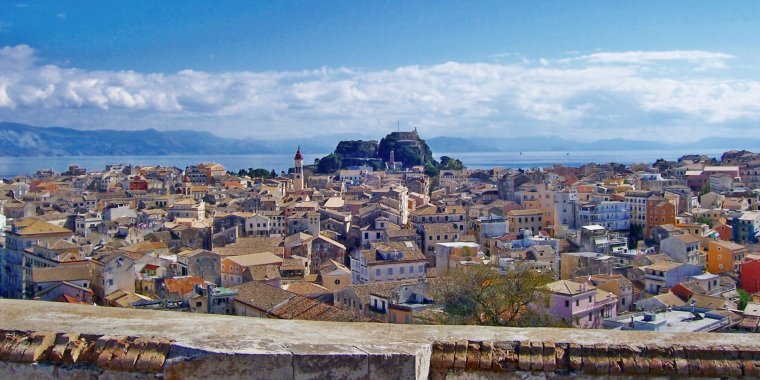
Panoramic view of Corfu (city) from the New Fortress. Greece. ![]()
Corfu, known also by its Greek name Kerkyra (Κέρκυρα), is the northernmost of the Ionian Islands in Greece. Located off of the far northwest coast of the country, Corfu lies in the Adriatic sea, east of Italy and southwest of Albania. Historically Corfu has been controlled by many foreign powers, notably the Venetians, and British.
The satisfactory infrastructure and the multiple possibilities for various activities are ideal for group holidays on Corfu and the nearby islands. Motivation trips, congress tourism, school trips, Ferrari or antique cars clubs and Harley Davidson groups meet here every year.

Corfu, Greece. ![]() Corfu's nature, sea and history have made sure so that you today, no matter when you come, or how long you will stay, or your style, you will certainly find original and interesting situations to exercise and to have fun.
Corfu's nature, sea and history have made sure so that you today, no matter when you come, or how long you will stay, or your style, you will certainly find original and interesting situations to exercise and to have fun.
In a place with a tradition in tourism of at least 130 years, with Greek education and the influence of “nobility” from England, France and, surely, Venice, in a place which is used to welcoming the international jet-set for several decades now, the possibilities for sports and amusement are certainly impressive.
Corfu may not have a Disneyland, children's museums, zoos or other things closely connected with children, but the whole island is ideal for children. It's one of few places in the world, where children are bound to find what they really need: a warm welcome. In Corfu there are no tropical diseases, criminality, violence, dangerous sea or other kinds of "dangers".
Children here, as you will see for yourselves, play safely in the streets, in the parks, at the playgrounds, on the beach. The way of life of the Corfiot people is almost in family. Check this out, and you will see that it is worth bringing here your children some time.
Climate
The climate of the archipelago of Corfu is warm Mediterranean. The summer here is warm and relatively dry with a blue sky, often cooled by seasonal breezes, offering the ideal conditions for surfing, while rarely is it interrupted by rains. The mountainous areas are cooler. The winter here is mild. Rainfall occurs mainly from November till March. On average, there are 3000 hours of sun per year with an average daily sunshine duration of 8.5 hours.
Spring here is impressive and offers visitors the privilege to enjoy the wealth of vegetation and colors, combined with high-taste tourism. Summer is the most popular season for Corfu, with beautiful beaches and crystal water for unconcerned hours on the beach.
Autumn is the season of vintage, the period during which the whole island smells of grapes; it may be the best time to get to know the routine of the island.
Easter celebration here becomes the experience of a lifetime. Christmas and New Year's Day in Corfu is music, hymns, carols, in a quiet, decorated place with a mild climate and a noble finesse.
Regions and Towns
Corfu is 62 km long and at its widest point, nearly 30 km wide. The island is formed by two mountain ranges. The northern runs from the west to east and consists of limestones, reached in the Mount Pantokrator (914 meters) the maximum height of the island, while the southern mountain range is less high and streches from north to south. The North of the island is wider and more mountainous.
The coastal areas are well developed with good pebbly beaches. However, the northeast coast has always remained a favourite, aka Kensington on sea. It is also where the island's oldest village 'Old Perithia' is located just beneath Mt. Pantokrator, a Heritage Protected Site in a designated Area of Natural Beauty. The South of the island is less wide (only a few miles across from west to east) and tends to have sandier beaches.
Corfu Town, known in modern Greek as Kerkira or Kerkyra, is the largest and most important town on the island. This is where the airport is located and where most cruise ships and long distance ferries dock. It is a small, pleasant city catering well to tourists.
The North of the island is wider and more mountainous. The coastal areas are well developed with good pebbly beaches.
The South of the island is less wide (only a few miles across from west to east) and tends to have sandier beaches. It also has a quieter and more genuine atmosphere especially south Messonghi on the east shore or Aloniki on the west shore.
Benitses is a very old, traditional fishing village. Benitses lies 12 km south of Corfu Town, and leads to the emerald valley. The water of the springs which flow from the mountains of Aghii Deka and Stavros, join together in two small rivers, giving the area the name Pinisse (derived from the ancient Greek word 'Pinio') = Pinitse = Benitses. The mild climate and the natural beauty of Benitses village has attracted a lot of tourists from the beginning of the century. It is only during the last 30 years that tourism has replaced all other sources of income and now is the sole occupation of the inhabitants during the summer season.
Gouvia is 7km north of Corfu Town. It is a typical touristic spot with a narrow pebble beach and does not deserve a long stay.
Messonghi (also known as Mesongí or Messogi). Another mainstream beach spot. You can use it as a base to go and explore the surroundings.
Get in
• Corfu "Ioannis Kapodistrias" airport (CFU) (IATA) is served by several airlines. Year-round both Aegean and Olympic airlines have flights to Athens. Also Sky Express flies from and to Corfu, from Preveza and several other islands such as Kefalonia, Zakinthos, Kithyra and Heraklion. In the high season (roughly easter through October), other airlines including German Wings, Easyjet, Air Berlin, TuiFly, LTU, Ryanair, Transavia and Wizzair serve the island.
You can reach the city center from the Corfu Airport by taxi, shared shuttle or book a private transfer upfront.
Attention: Whenever you have a printing facility around you, make sure you check your return flight on line and have your boarding passes printed. This will give you peace of mind as leaving it for the last minute could be stressful: There aren't many webcafés or hotels with printers around. This is particularly recommended for Ryanair passengers as they charge you hefty just to print a boarding pass!
• Local Taxis. The authorities regulate tariffs for all licensed taxis. If the taxi is licensed, it displays a rate card in the window or on the dash. In case you don´t see any rate card, ask the taxi driver for the rate. The approx. cost of a ride from the airport to the city is 10 Euro. Taxis are obliged by law to issue receipts, however many tend to "forget" it, or even not starting the taximeter.
• Shared Shuttle. Shared Shuttle Service can be reserved online. The approx. cost of a ride from Corfu Airport to Corfu is 16 GBP/person.
• Private Airport Transportation. If you prefer not to share a car with other people you can book a private transfer from the airport in advance. Most companies, which offer this service, require the booking has been made at least 24 hours in advance.
— Easy Private Taxi has Corfu Airport to the city at €25 for a sedan, €60 for a minibus 8-seater
— Corfu Airport Transfers has Corfu Airport to the city at £30.44 for a sedan, £49.95 for a minibus
• By Local Bus. Local bus number 15 goes from the airport to corfu town.
• By boat. Direct Ferry links exist to/from Venice, Ancona, Bari, Brindisi (Italy), Himara and Saranda (Albania) and Igoumenitsa, Patra (Greece) . As of March 2008, a bunk in a four- person cabin from Venice to Corfu was €107.
Cruise ships dock at Corfu's New Port, which has a terminal with a welcome center (pick up an excellent town map). Outside the terminal to your left is a long parking lot with rental cars and taxis, and beyond that a public bus stop. From the New Port, you can see the Old Fortress, about 3 km to the east. To get to the Old Fortress, you can take a shuttle, if the cruise ship provides one ( €7), or a 10-minute taxi ride for about €17, or walk along the seafront for about 30 minutes. There is also a public bus (Port / Kefalomandouko No.2b Blue Bus Stop) at the end of the large port parking lot that will take you to Old Port Square by the New Fortress for approx €1.50. More information can be found in a port guide.
• In your own yacht. If you come in your own yacht the Marina, Gouvia offers you a comfortable stay, very close to Corfu town, while in the town you can moor off at the NAOK harbour, as well as at the Old Port. You can also moor off at Benitses Marina, not far from Corfu town.
Get around
• By bus. There are two types of buses in Corfu - Blue buses serve Corfu town and the environs, Green buses serve the rest of the island. The Blue bus terminal in Corfu Town is in San Rocco Square. The bus information kiosk displays timetables and provides maps showing exactly where the buses terminate (some terminate a few blocks south of the square). Bus stops have electronic displays, and self-service ticket machines.
Tickets are single-journey only and must be validated on the bus. They can be bought from the machines, or from the driver (for €0.50 more) (see full timetable here. Useful lines include the number 7 which goes to and from Dasia every 20 minutes (30 minutes on Sundays), the 10 which goes to and from Achilion every two hours, the 6 to and from Benitses (not quite hourly) and the 11 to and from Pelekas every 2-3 hours.
The airport bus is No 19 - check the timetable as frequency varies during the day with some big gaps. It is only a ten-minute ride, and costs €1.10. Number 6 Benitses bus also goes past the end of the airport access road from where it is a 500m walk to the terminal.
The Green Bus Station is near the New Port, from where buses depart for all villages of Corfu Island.
• By taxi. There are plently of taxi lines in Corfu Town: between the Spaniada and the cricket ground, at the heart of the shopping center of the town in Methodiou street, at the Old Port, at the New Port, many others in Gouvia, Dassia, Benitses, Ipsos, the Airport etc.
• By car. You can rent a car at the airport or through one of many local companies. International franchises such as Hertz have counters at the airport and the main ferry terminals). For your peace of mind, you may opt for one of these as some travellers have had bad experiences with lesser known companies and their so-called 'full' insurance coverages. In general, it is cheaper to pre-book a car rental via the Internet before arriving.
Many of the roads are very narrow so it can be better to choose a small car. While there is a good road running North-South along the East coast from Sidari to Lefkimmi and from Corfu town across the island to Paleokastritsa, many roads have poor surfacing. Often the insurance provided for hire cars does not cover damage to the underside of the car so watch out for large holes in the road.
Car rental companies often provide a free map but you may find it worth buying one in advance as the maps are not especially good, especially for the North-West interior. Unfortunately online mapping tools like Google Maps are not accurate enough to offset the low accuracy of some addresses so it is highly recommended you come with your own GPS device. Also, be careful to rent Quads in Ypsos. Some local companies have been reported to rent out unsafe and faulty Quads.
• By boat. A great way to explore the island and access beaches that can't be easily accessed otherwise is to rent a boat. Most towns have at least one boat rental company and boats up to 30HP do not require a licence to hire.
• By bicycle. An automatic bike sharing scheme, called EasyBike Brainbox is available to rent bicycles.
What to see in Corfu
• Old Perithia, Old Perithia, Corfu (Located in the north east). Old Perithia is Corfu's Oldest Village. A Heritage Protected Site in a Designated Area of Natural Beauty. The village is locates at 408m above sea level and nestles below Mount Pantokrator, it was once a hideaway from pirate attacks with a look out tower from which you could see, but not be seen from the sea.
There are 8 churches and 130 houses, some in various states of disrepair, but the village offers an excellent example of the Venetian influence on the island and it is said that Old Perithia was once the wealthiest of the villages. In its heyday, It had an abundance of oak trees, vines and thousands of sheep roaming the mountainside. As olives would not grow so well at this height, the oaks and vines remained, along with other fruits, cherry, fig, walnut and almond to name but a few.
There is on four star accommodation in the village, The Merchant's House B&B, and four tavernas - that are open all summer, and at weekends throughout the winter. The village is located 7km up from the coast road, opposite Ice Dreams, and clearly signposted. Most of the 8 churches are family owned but Agios Iakovos Persis, the church at the (now) entrance to the village is being lovingly restored and contains some remarkable frescoes inside. It is due to open to the public from late 2014. Parking is limited and there is a no through sign as the village is only accessible to the few residents who currently live there.
• Old Town of Corfu
— The Esplanade (Spianada), between the Old Fortress and Old Town. This huge open parade ground and park, just west of the Old Fortress, is bordered on the north by the old royal Palace (now the Museum of Asian Art) and on the west by the Liston, built by the French under Napoleon to resemble the Rue du Rivoli in Paris. Some say the Esplanade is the most beautiful esplanade in Greece.
— Old Fortress (Paleo Frourio), eastern point of Corfu town peninsula. Apr-Oct, Tue-Sun 8am-4pm; Nov-Mar, Tue-Sum 7am-3pm. Built by the Venetians in 1546 on the site of a Byzantine castle, the fortress is separated from the rest of the town by a moat. Its two peaks ("korypha") gave the island its name. To the west, you have a gorgeous view of the town and to the east the mountainous Albania coast. Most of the Venetian fortifications inside were destroyed by the British, who replaced them with their own structures, like the Church of St. George, built to look like a Doric temple. €4.
— Palace of St. Michael and St. George (Palaia Anaktora), at the north end of the Esplanade. Tue-sun, 8:30am-4pm. This elegant 19th century Regency palace, site of the 1994 EU Summit, houses the Museum of Asian Art, a notable collection of Asian porcelains, Japanese ukiyo-e prints, Indian sculpture, and Tibetian temple art. €3.
• Nymphes. A big village with a lot of water, green and legends built on a height of 200 meters. According to a legend, in old times, the Nymphs used to bathe in the village's waterfalls. A walk to the wells and the waterfalls is enough to make you understand why this legend exists! It is almost certain that you will come across a nymph, too and if you are lucky, you will see her bathe in the water especially in spring.
After your walk to the myths, it is a good idea to visit the premises of the Agriculture Co-operative which elaborates kum-kuat and produces liquor and sweets. You will be offered some for free and you will have the chance to try the different liquor qualities (and of course, buy some, if you like).
Just outside the village, you can visit Askitario, a small but historic monastery. According to tradition, here lived in the 5th century the monk Artemios Paissios from Epirus, who is said to have worked many wonders.
• Kynopiastes. A traditional village of the Messi Region of Corfu and only 10 km away from Corfu town and airport, which is a must visit. Old mansions of the 17th to 19th centuries, a marble church, a 17th century monastery and a museum (and the only one on the island) devoted to the olive tree with one of the world famous restaurants on the island tavern « Trypas ».
The narrow tiled paths invite you to walk on them, looking at the small squares and at the houses which preserve the traditional colors. The main church is devoted to the Virgin Mary and it is in the central square. It is a traditional church with unique architecture and an impressive marble entrance. Inside, there are frescoes of the 18th century Ionian School of Painting. At the edge of the village there is the monastery of Agia Paraskevi, built in the 17th century.
• Lakones. A typical Corfiot village on the slope of a green hill. You should go for a walk to Bella Vista to admire the view over the bay of Paleokastritsa and relax in one of the picturesque coffee shops. If you like trekking there is a path leading down to Paleokastritsa. The surnames of the inhabitants of the region refer to the soldiers who supported Angelokastro in the late Byzantine period, as well as to refugees from Mani.
Among the houses of the 18th and 19th centuries you will find churches and traditional coffee shops. At the central church you will see donations of the first emigrants to America of the late 19th and early 20th centuries.
• Roda. Visit the village resort of Roda on Corfu's northern coast. Traditionally a fishing village, the area has retained its chararcter while developing in to a popular destination for holidays. Unique in the sense that the old village still exists at the heart of the resort, locals mix with the different nationalities who visit time and time again. Roda is a contained resort, without the typical sprawl.
There is plenty of accommodation, bars, restaurants which offer a wide range of menus, typical Greek and Corfiot dishes, Italian, Chinese and others. Roda is a relaxed resort but has a good nightlife, with nice bands, singers and comedy shows as well as the ever popular kareoke. If you want a laid back holiday, then Roda is the place, with quiet corners and a beautiful sandy beach, Roda offers something for everyone.
• Achilleion. Achilleion (Αχίλλειον) is a palace built in Corfu by Empress of Austria Elisabeth of Bavaria, also known as Sissi after a suggestion by Austrian Consul Alexander von Watzberg. Sissi was a woman obsessed with beauty and very powerful but tragically vulnerable since the loss of her only son, Crown Prince Rudolf of Austria in the Mayerling affair in 1889. A year later in 1890 she built a summer palace in the region of Gastouri (Γαστούρι), now the municipality of Achilleion, about ten kilometres to the south of the city of Corfu. The palace was designed with the mythical hero Achilles as its central theme.
What to do in Corfu
• Corfu Golf Club, Ermones. Located only 14 km away from Corfu Town and 900 metres from the beach, Corfu Golf Club was designed in 1969 by the famous Swiss based architect Donald Harradine, who blended the natural beauty of the Ropa Valley with manmade hazards to make the course a good but fair test, enjoyable for all categories of golfers. The tree lined fairways and the bunkers combine with several lakes and meandering streams, to make an attractive picture against a backcloth of hills and mountains. · The course is open 7 days a week, from 08.00 until 18.00 (office hours), though you may play until dusk. Buggies, clubs, trolleys and lockers are available for rent, and the restaurant offers a fine selection of Greek dishes.
• Aqualand, Agios Ioannis. It's quite a small water park with only a few main "rides". It is best to travel to and from the park under your own steam as a whole day there with an organised trip might be too long.
• Benitses (Benitses). A former fishing village and one of the most traditional Corfiot villages with unique natural beauty and a very popular and famous tourist destination, used to be the first tourist resort of Corfu. is situated on the Eastern coast of Corfu, only 12 kilometers from Corfu town, and 9 kilometers from the international airport Ioannis Kapodistrias.
The coastal road of Benitses is full of hotels, restaurants, cafes and other shops that offer everything the most demanding visitor can ask. Benitses is surrounded by the mountains in one side and the aquamarine waters of the Ionian Sea in the other, this unique combination of nature with the hospitality of the residents, which are very familiar with different cultures, are what make visitors to love the place. 2 miles to the north there is the famous Achilleion palace.
Beaches
On the West side of the island, the beaches are sandier while the East tends to have calmer waters.
• Sidari. A fair sized resort dominated by British tourists. At one end of the beach is the "Canal de l'Amour": sand stone cliffs with narrow inlets, a natural archway and small paths to explore.
• Dasia and Ipsos. A narrow stony beach with relatively calm waters. The resort runs along the road so there's a good variety of shops and tavernas.
• Kassiopi. One of the more relaxed and atmospheric resorts with a pretty bay and beach that is mostly stony. The waters are crystal clear and calm. Somewhat spoilt by the prevalence of tacky tourist bars/cafes catering to the many English tourists that crowd the town.
• Glifada. A long wide sandy beach with fairly rough waters. The resort is somewhat isolated.
• Pelekas beach. Even more isolated than Glifada. Also a nice sandy beach.
• Lefkimmi beach. A wide long sandy beach that is quiet due to being in the less busy South. There's a practical taverna with a children's playground. The waters are extremely calm and very shallow, even out for quite some distance.
• Barbati beach.
• Chalikounas beach. A very long, virgin stretch of land, caught between Chalikiopoulos' Lake and the Adriatic sea. The natural landscape here is unique, it is a great place to get away from the world and just enjoy both sea and sun away from the mass tourism crowds. You can rent a pair of long chairs for 6 euros a day. You can also take kite surfing lessons next to the bar.
• Issos beach. Next to Chalikounas, again on the southwest of Corfu, this beach has a desert motive, because of the high sand hills right next to the seashore. Bring your bike and enjoy the terrain, or just enjoy the panoramic view from high above.
• Prasoudi beach. High cliffs hang over your head, clean waters and a mix of sand and pebbles on this remote beach.
• Messonghi beach. Gentle current, ideal for children, clean water with sand, pebbles and plenty of little fish.
• Benitses. A former fishing village and one of the most traditional Corfiot villages with unique natural beauty and a very popular and famous tourist destination, for many decades used to be the first tourist resort of Corfu, it is situated on the Eastern coast of Corfu, only 12 kilometers from Corfu town, and 9 kilometers from the international airport Ioannis Kapodistrias.
The coastal road of Benitses is full of hotels, restaurants, cafes and other shops that offering everything the most demanding visitor can ask. Benitses is surrounded by the mountains on one side and the turquoise waters of the Ionian Sea on the other, just 2 miles to the north lays the famous Achilleion palace.
Walking
Corfu is an ideal location for a keen walker. The North is fairly rugged with Mt. Pantokrator, the highest mountain. Beneath the mountain is Corfu's oldest village, Ano (Upper) Perithia. At the other extreme is Korission Lake (in the South), an inland lake, separated by a thin sand bar from the sea.
The Corfu Trail is a 222km long distance footpath covering the full length of the islands. The route is well signed and a book accompanies the trail, there is also an introduction, history and walking guide for Old Perithia, Corfu's oldest village which you pass through on the Corfu Trail.
Get out
Corfu makes a good start for a tour of the Western Greek Islands. It's also a good jumping-off place to get to Italy or Albania. Day trips to Paxi and Sarande are popular, usually combined with an excursion to the UNESCO World Heritage site of Butrint which is to be highly recommended! A tour of the Albanian Riviera is a must! (Wikivoyage/Wikitravel)
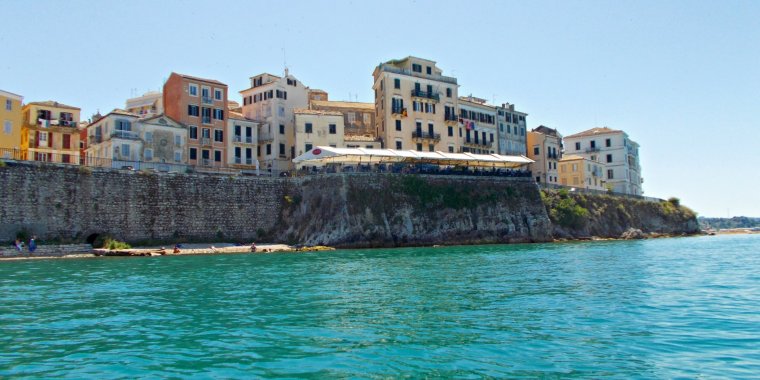
Corfu city from the sea. Greece. ![]()
YOU MAY ALSO LIKE
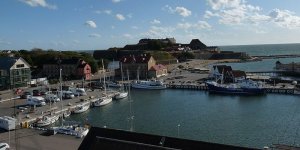
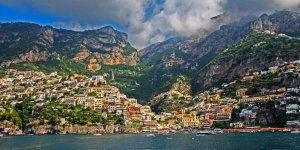

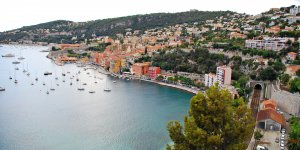


 If you own or manage a travel-related business such as a hotel, a bed-and-breakfast, a restaurant, a pub or a cafeteria, you can create a web page for your business for free on Titi Tudorancea Travel Info. » |